Feature Article - "Cinesphere, The
World's First Permanent IMAX® Facility" - July, 2001
Brian Florian
![]()
|
Approaching "The Sphere" |
It's Expo 1967 in Montreal Canada and multi-screen film presentations are the rage of the renowned international fair. Canadian entrepreneurs and filmmakers Graeme Ferguson, Roman Kroitor, and Robert Kerr actually produced some of the films being shown, but made a decision to create a single projector/screen motion picture system which would equal or surpass the grandeur of the cumbersome multi-camera systems. IMAX® corporation was born.
By Expo 1970 in Osaka, Japan, IMAX was ready to be demonstrated to the public. The Cinesphere opened the following year at Ontario Place in Toronto as the first permanent IMAX facility.
Visually distinctive with its triodetic-domed structure, in
1971 it was one of the world's most advanced theatres, and today remains an impressive
facility. Built to "create a space capable of housing the existing and
the future scope of film", it could accommodate all conventional film formats and
also many of the experimental films produced for Expo '67 in Montreal and Expo '70 in
Osaka.
Celebrating its 30th anniversary, we headed over to Ontario Place for a day of
water-slides, rides, boats, and an IMAX feature: "Amazing Caves".
After the film, we were taken up to the projection room where we were introduced to Gordon
McLeod, Projection and Sound Engineer since 1979.
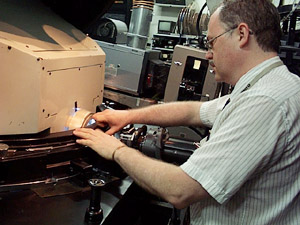 |
Threading the next feature |
Barely did we shake hands than Gordon glides over to the front of the mammoth projector and starts threading the next feature into place. Cinesphere shows between 7 and 12 features a day to as many as 752 people each time, distinguishing it as having one of the highest seating capacities of any IMAX facility. But they almost never run the same feature twice in a row, so Gordon is a busy man. We appreciated the generosity of his time and stayed well out of his way. Running the multi-million dollar set-up is clearly second nature to him, and he has no problem talking and answering our questions as he goes along.
As we are going to explain, IMAX is many things, but the most prominent element is size. It's huge. You can't just move a projector back to get a bigger image because the quality goes to pot. If you want a bigger screen, you need a bigger film. IMAX is based on 70mm stock, but unlike cinematic 70mm which runs vertically, IMAX runs horizontally using 15 perforations per frame. This makes for a frame 3 times larger than the legendary 70mm format, or 10 times what you are used to seeing at an everyday theater. It's immediately apparent when you look at the comparison frame sizes beside each other (photo below) that IMAX is able to be projected on the Cinesphere's 86 foot wide/60 foot tall screen with uncompromised clarity. But big frame means a big projector.
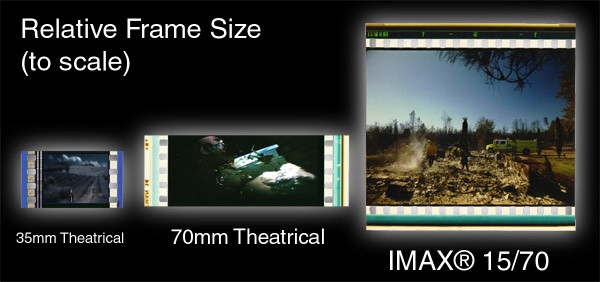
 |
Looking at the back of the behemoth |
Cinesphere's IMAX projector is the world's first and is the only one which is actually owned by the facility using it (all other installations lease the equipment). Despite that fact, it is in as good a shape today as when it first went into service 30 years ago. It takes both standard 24 fps IMAX features as well as 48 fps IMAX-HD® features (which run at a wicked speed of 673.2 feet per minute). It takes a whole room underneath the booth to house the backup components: A huge air compressor for the projector mechanism, an arc-welder power supply, specially converted to run the 15,000 watt Xenon lamp, and a rather large water pump. At running power, the lamp would burn a hole through a 2x4 board in a matter of minutes if placed in the film path. Cool water is circulated through the lamp housing, bringing the temperature down to a point where the moving film won't suffer from the heat. Projecting a frame as large as IMAX on the 7 story tall screen calls for a lot of light!
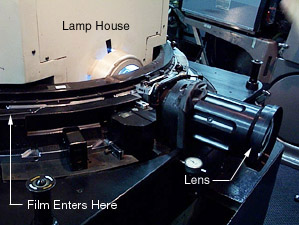 |
Film path past the gate/lens |
But, a big frame is just the foundation. The IMAX system encompasses many innovations which further the clarity and definition of the image far beyond what conventional 35mm motion pictures can achieve at any size. Motion picture film (of any type) does not travel continuously past the lens. Each frame is "paused" long enough for a flash of light to be passed through it. Your local multiplex more than likely has equipment which uses the ubiquitous "Geneva movement", a claw-like action that works for small formats like 35mm, but would be abusive on the massive IMAX format.
IMAX adapted and enhanced the Rolling Loop system, invented by Ron Jones, for its projectors. As indicated in the photo at right, the film is brought in from the side and handled by the continuously revolving mechanism. The compressed air is key at this stage as it is what propels and cushions the film. As it enters, a loop of film amounting to one frame is sucked into a cavity. As it approaches the lens, the loop slips across the gate, leaving a frame sucked against fixed registration pins by vacuum. It gets its flash of light, is moved on by the next loop, and smoothly leaves the circle. Its best thought of as a caterpillar like movement, very fluid and easy on the film. With proper handing, an IMAX print can be run over 3100 times before getting worn. Brushes and pads clean the film as it is brought into the projector, and all the prints are handled with love and care. Humidity is carefully maintained.
The Rolling Loop makes for a remarkably stable image. Pay attention next time you are at a movie theater and you'll notice jutter and weave: The frames of the film are not in the exact same position when light is flashed through them making things unstable. Not so with IMAX and its Rolling Loop. It's rock solid.
An IMAX presentation has noticeably better contrast and deeper blacks than conventional movie presentations, thanks not to anything fancy in the film, but a better lens at the projector.
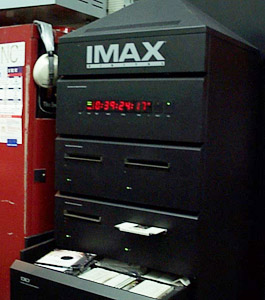 |
The IMAX® Digital Audio Reader |
IMAX sound comes in two flavors: Digital and Analog. The digital sound reader hardware pictured here (photo at left) was added to the Cinesphere in 1991 for the premiere of the IMAX film "At The Max" - a 90 minute Rolling Stones concert experience. It takes as many as 3 CDs per film to deliver the 24 bit uncompressed audio. Both digital and analog systems have 6 full range channels: Left Front, Center, Right Front, Ceiling (at the top of the screen), Left Surround, and Right Surround. Older features have analog sound, and the new ones still include it as a backup to the digital. A big reel of 35mm film stock, coated with magnetic particles, contains the 6 tracks of magnetic analog sound and plays on a separate machine.
"Some people actually prefer the analog soundtrack" says Gordon, "especially on stuff with a lot of music. They find the sound warmer".
I can just imagine: 35mm stock has plenty of room for 6 channels of sound.
"How does the picture and sound stay in sync?" I ask. "Is there a time code on the film like a 35mm DTS print?"
"No, there is nothing on the film." Gordon explains. He points out the starting frames of the IMAX print with the words Start Sound on them. "I advance the film to this point, do the same with the sound, and lock the two machines in sync. From that point on, when the projector moves, the sound moves. Watch . . ."
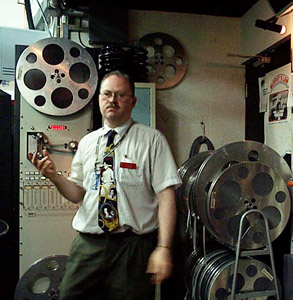 |
Gordon shows us the 6-track analogue audio system (looks like a projector) |
He manually advances the IMAX print a couple frames, and the analog sound reel next to me obediently advances the same amount at the same rate.
From either format the sound goes over the processing rack where it can be monitored, adjusted, and routed through the digital EQs. The power amplifiers are so numerous, there is no space for them in the booth! There are 16 Sonics®/Bryston® 4B amplifiers and 7 Sonics/Bryston 3B amplifiers for the IMAX sound. These are Bryston amplifiers which are specially fitted by Sonics Associates with a custom input module that contains the crossover for that channel. Each channel therefore is a 4-way, quad-amped system (low, mid, high, extra high). For 70mm ToddAO style mag prints, another 9 Bryston 4B amplifiers kick in to deliver the extra two screen channels and surrounds. Lastly, two Cerwin Vega amplifiers drive the 4 Sensurround subwoofers. Total power at Gordon's command: 24,600 watts! Serious image calls for serious sound, and Cinesphere has the goods!
The large expanse of the IMAX theater makes for a rather different sound space than what you find in a typical soundtrack mixing stage or even a regular theater. For the creation of the IMAX film "Skyward", the Cinesphere was temporarily fitted with mixing facilities in the middle of its seating area so that the soundtrack could actually be crafted in the environment and over the sound hardware it would ultimately be enjoyed with.
But IMAX is not all that goes on at the Cinesphere. To either side of the IMAX projector are two more traditional machines for 35mm and 70mm movies. On the other side of the room we can see the rack of standard cinema sound hardware. "We've got the Dolby CP-200 of course," muses Gordon, "with every add-on and toy Dolby has ever made for it. We also do Dolby SR-D, DTS, DTS-70mm, and 70mm ToddAO magnetic".
"70mm!" I exclaim. "Bet you don't get much of that."
"Actually we do a fair amount," Gordon replies.
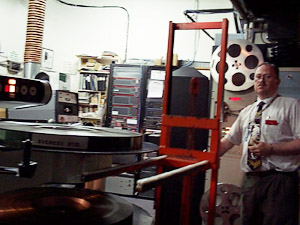 |
The forklift needed to move an IMAX® print |
"Must be blow-ups from 35mm prints".
"Some are, but we have stuff like "Lawrence of Arabia" on 70mm that we bring out from time to time".
"Really? What condition is the print in?"
"Perfect!" Gordon declares. "It's a recent reprint."
"Lawrence of Arabia", 79 feet wide: Now that is how the movie was meant to be seen!
With the next show ready to go and the previous one rewound, Gordon wheels in a sort of manual fork lift.
"At the Max is one of our longest features. It weight 315 pounds, so we use this lift to get the movies on and off the projector."
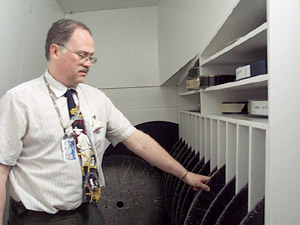 |
The Cinesphere's "Movie Collection" |
Once off the projector, he deftly flips the platter on its side and rolls it out the door. We follow him to the storage room. Cinesphere's entire movie collection is in here. "Most places rent the film" he explains. "We buy them and license the right to show them."
Back in the booth it's time to start the next show. With the press of a button, the system comes to life. It takes a full 8 seconds before everything ramps up to speed. After all, it has the inertia of 200 to 300 pounds of film to contend with. The system is actually a lot quieter than a typical 35mm projection room.
I've seen many IMAX features and always enjoy the amazing experience, but thanks to the generosity and courtesy of the Ontario Place staff, we now understand what is involved in bringing that enormous image to life 12 times a day. If you or someone you know has never been to an IMAX, you owe it to yourself to see the absolute bar-none finest visual and aural experience in existence!
Cheers and happy watching!
- Brian Florian -
I would like to thank Sherry Lawlor of Ontario Place for setting up the tour and especially Gordon for allowing us to invade the sacred room for a few brief minutes.
![]()
© Copyright 2001 Secrets of Home Theater
& High Fidelity
Return to Table of Contents for this Issue.


